Презентация What role does Kazakhstan play in oil
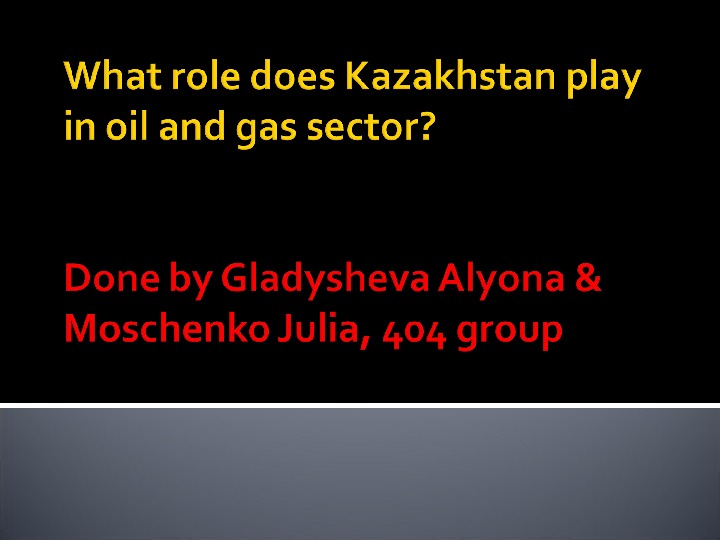
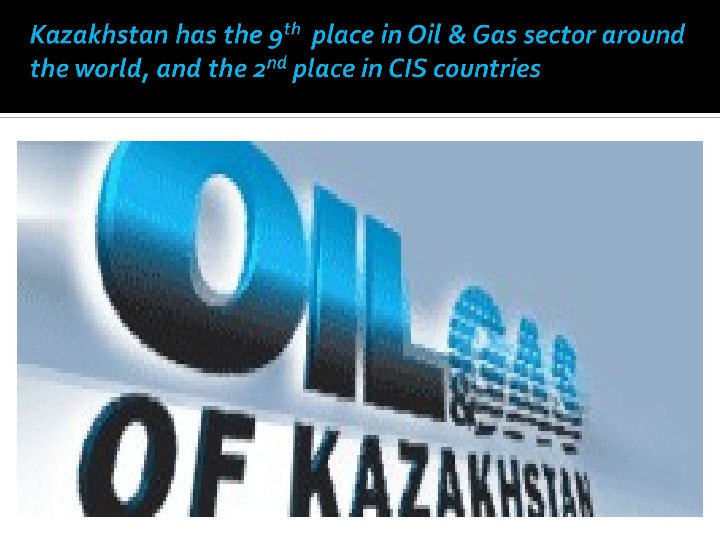

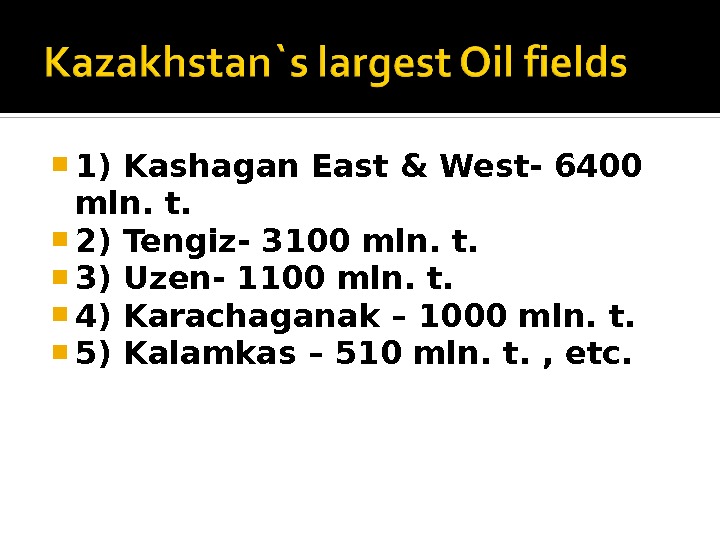
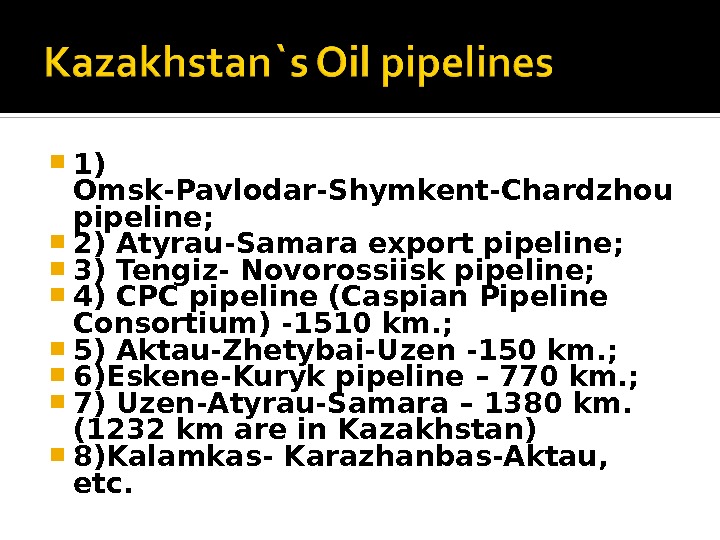

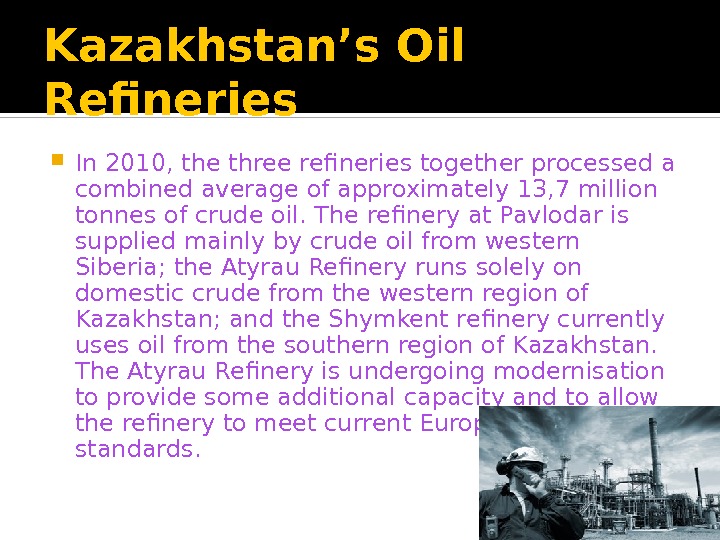


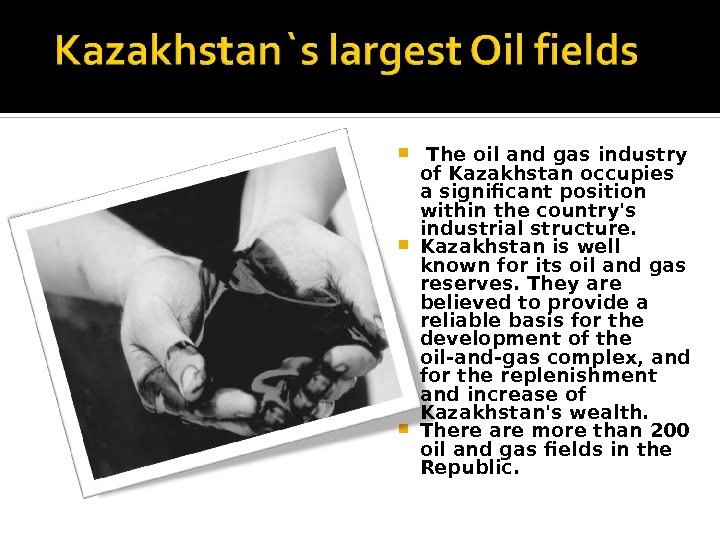
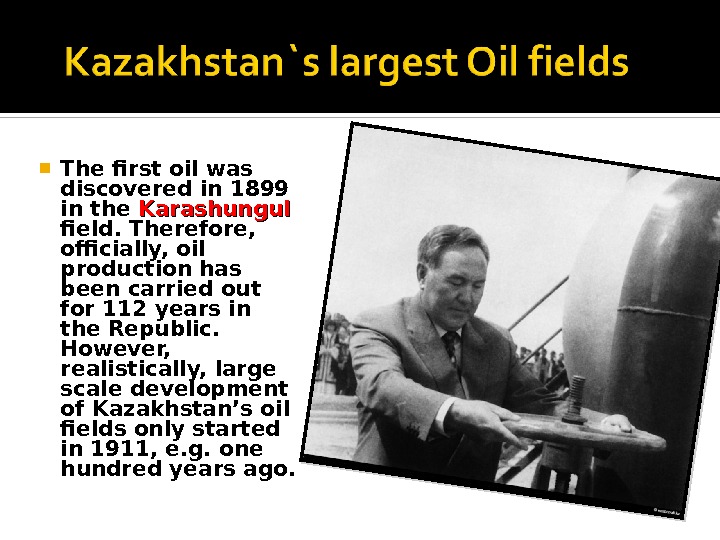
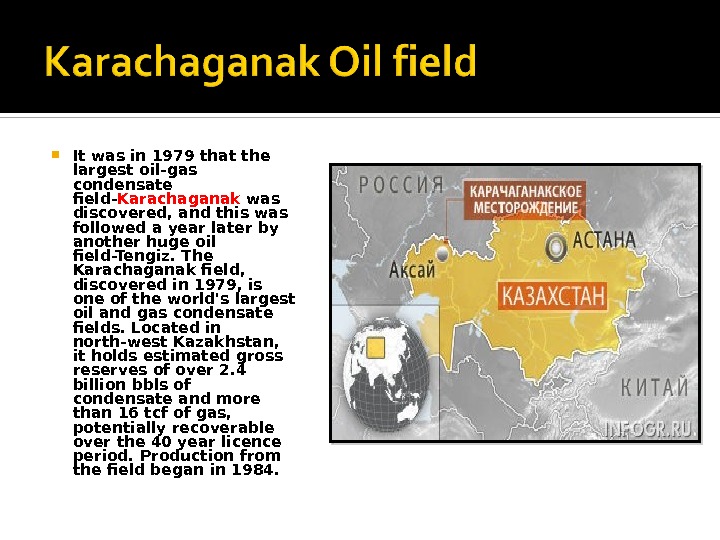

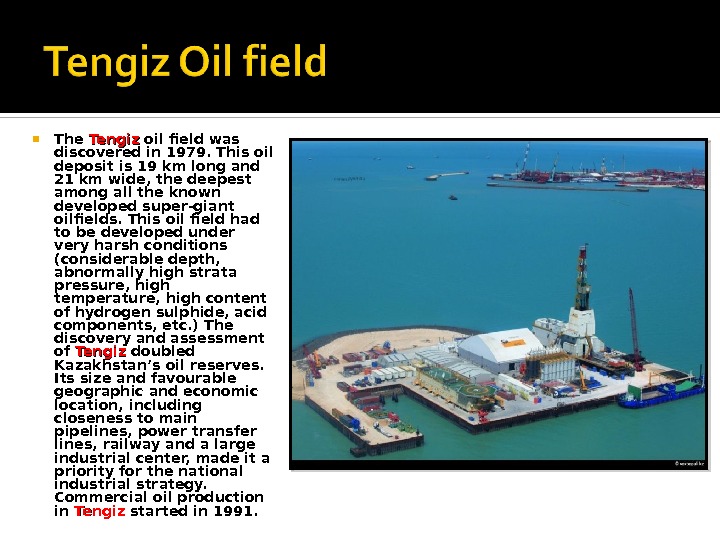
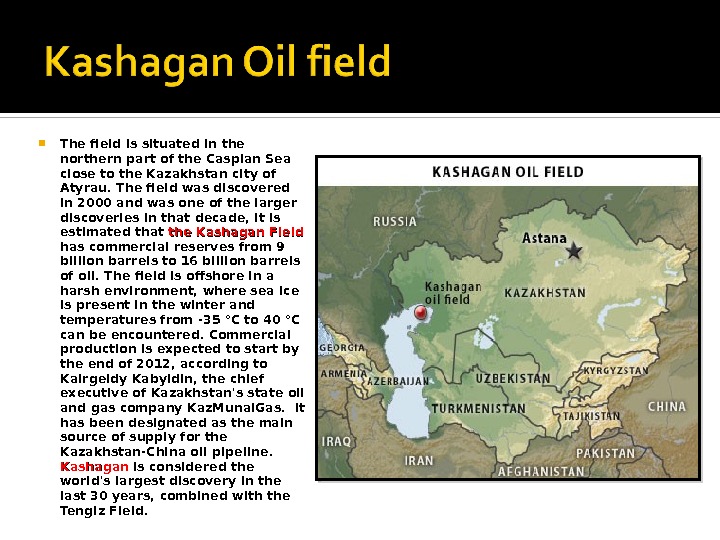
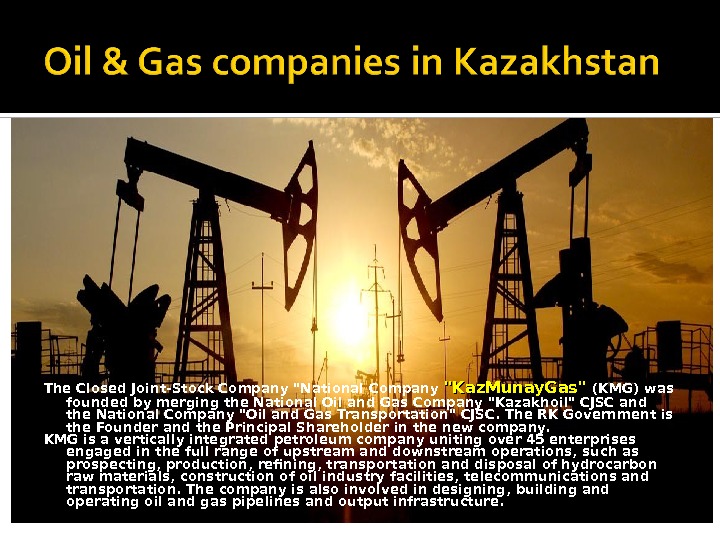
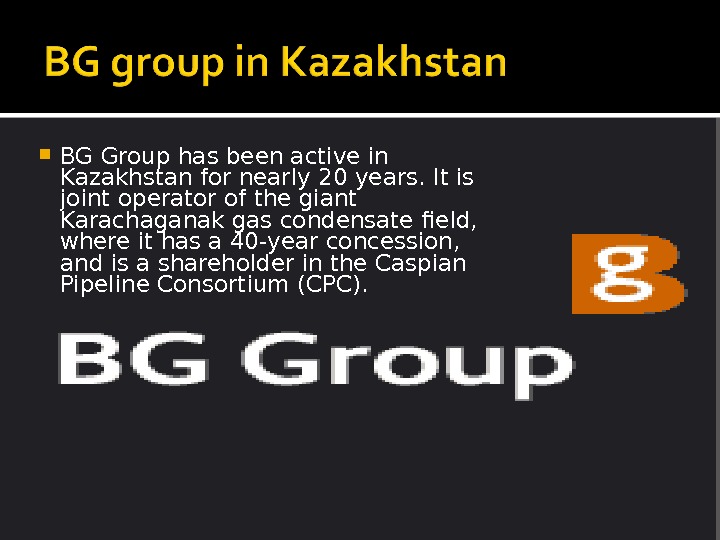
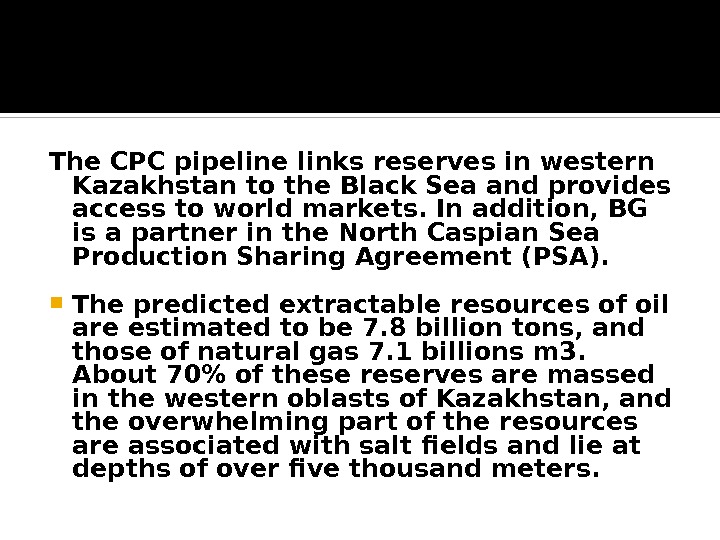
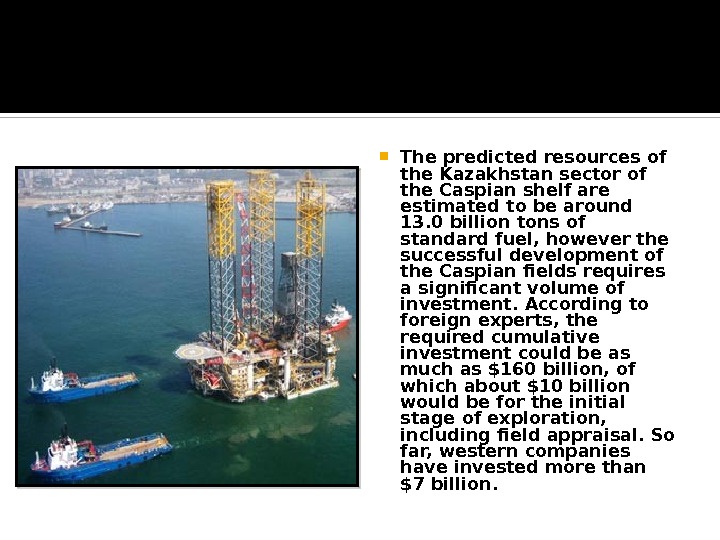
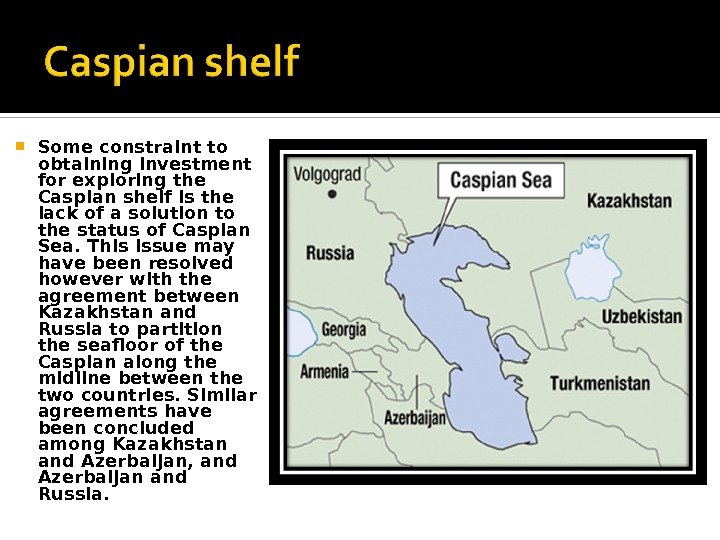

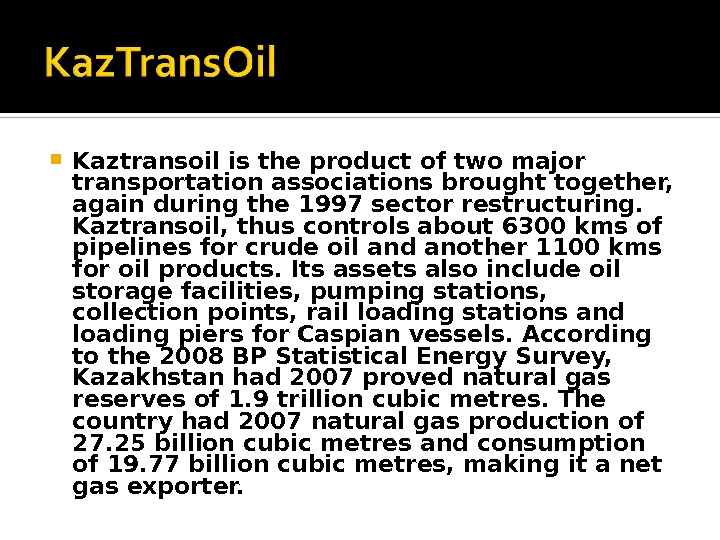
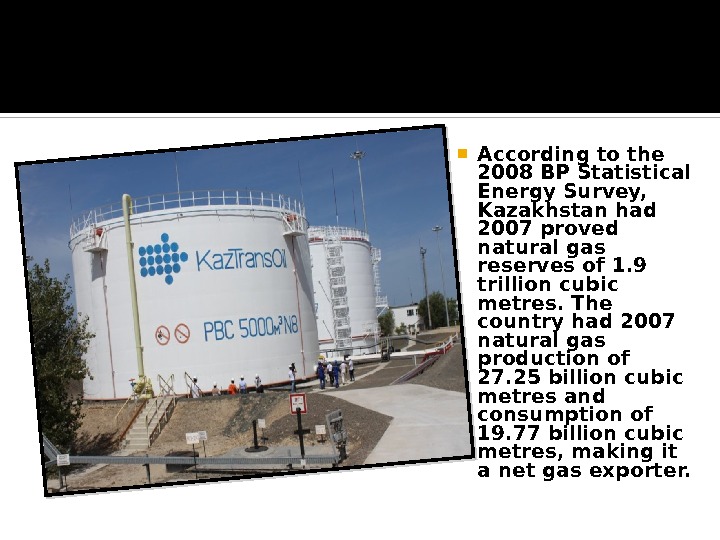

- Размер: 6.1 Mегабайта
- Количество слайдов: 24
Описание презентации Презентация What role does Kazakhstan play in oil по слайдам


 Kazakhstan is rich in natural resources, but oil for the Republic is something more than just one of its resources. Our country is associated with oil all over the world and this industry has had a significant impact on the development of the country.
Kazakhstan is rich in natural resources, but oil for the Republic is something more than just one of its resources. Our country is associated with oil all over the world and this industry has had a significant impact on the development of the country.
 1) Kashagan East & West- 6400 mln. t. 2) Tengiz- 3100 mln. t. 3) Uzen- 1100 mln. t. 4) Karachaganak – 1000 mln. t. 5) Kalamkas – 510 mln. t. , etc.
1) Kashagan East & West- 6400 mln. t. 2) Tengiz- 3100 mln. t. 3) Uzen- 1100 mln. t. 4) Karachaganak – 1000 mln. t. 5) Kalamkas – 510 mln. t. , etc.
 1) Omsk-Pavlodar-Shymkent-Chardzhou pipeline; 2) Atyrau-Samara export pipeline; 3) Tengiz- Novorossiisk pipeline; 4) CPC pipeline (Caspian Pipeline Consortium) -1510 km. ; 5) Aktau-Zhetybai-Uzen -150 km. ; 6)Eskene-Kuryk pipeline – 770 km. ; 7) Uzen-Atyrau-Samara – 1380 km. (1232 km are in Kazakhstan) 8)Kalamkas- Karazhanbas-Aktau, etc.
1) Omsk-Pavlodar-Shymkent-Chardzhou pipeline; 2) Atyrau-Samara export pipeline; 3) Tengiz- Novorossiisk pipeline; 4) CPC pipeline (Caspian Pipeline Consortium) -1510 km. ; 5) Aktau-Zhetybai-Uzen -150 km. ; 6)Eskene-Kuryk pipeline – 770 km. ; 7) Uzen-Atyrau-Samara – 1380 km. (1232 km are in Kazakhstan) 8)Kalamkas- Karazhanbas-Aktau, etc.
 Kazakhstan’s Oil Refineries Kazakhstan has 3 oil refineries located in Pavlodar (northern region), Atyrau (western region) and Shymkent (the South) with an estimated total refining capacity currently standing at ~430, 000 barrels of oil per day.
Kazakhstan’s Oil Refineries Kazakhstan has 3 oil refineries located in Pavlodar (northern region), Atyrau (western region) and Shymkent (the South) with an estimated total refining capacity currently standing at ~430, 000 barrels of oil per day.
 Kazakhstan’s Oil Refineries In 2010, the three refineries together processed a combined average of approximately 13, 7 million tonnes of crude oil. The refinery at Pavlodar is supplied mainly by crude oil from western Siberia; the Atyrau Refinery runs solely on domestic crude from the western region of Kazakhstan; and the Shymkent refinery currently uses oil from the southern region of Kazakhstan. The Atyrau Refinery is undergoing modernisation to provide some additional capacity and to allow the refinery to meet current European fuel standards.
Kazakhstan’s Oil Refineries In 2010, the three refineries together processed a combined average of approximately 13, 7 million tonnes of crude oil. The refinery at Pavlodar is supplied mainly by crude oil from western Siberia; the Atyrau Refinery runs solely on domestic crude from the western region of Kazakhstan; and the Shymkent refinery currently uses oil from the southern region of Kazakhstan. The Atyrau Refinery is undergoing modernisation to provide some additional capacity and to allow the refinery to meet current European fuel standards.
 1) Amangeldy (Zhambyl oblast); 2) Arman (Mangystau oblast); 3) Zhalgiztobe (Mangystau oblast); 4) Karachaganak; 5) Kisimbai (Atyrau oblast); 6) Zhetybai (Mangyshlak peninsula), etc.
1) Amangeldy (Zhambyl oblast); 2) Arman (Mangystau oblast); 3) Zhalgiztobe (Mangystau oblast); 4) Karachaganak; 5) Kisimbai (Atyrau oblast); 6) Zhetybai (Mangyshlak peninsula), etc.
 Kazakhstan’s Gas Refineries The Kazakh Gas Refinery is very important for production- territorial complex of Mangistau. The plant provides the major part of the Republic by condensed gas, the population of the region by residue gas and stove fuel. Also it provide the companies of the Zhanaozen city by technical oxygene. With development of a new perspective deposit of Zhanazhol (1986, 40 km from Kenkijaka) have begun building of Zhanazhol oil & gas refinery. Tengiz Refinery
Kazakhstan’s Gas Refineries The Kazakh Gas Refinery is very important for production- territorial complex of Mangistau. The plant provides the major part of the Republic by condensed gas, the population of the region by residue gas and stove fuel. Also it provide the companies of the Zhanaozen city by technical oxygene. With development of a new perspective deposit of Zhanazhol (1986, 40 km from Kenkijaka) have begun building of Zhanazhol oil & gas refinery. Tengiz Refinery
 The oil and gas industry of Kazakhstan occupies a significant position within the country’s industrial structure. Kazakhstan is well known for its oil and gas reserves. They are believed to provide a reliable basis for the development of the oil-and-gas complex, and for the replenishment and increase of Kazakhstan’s wealth. There are more than 200 oil and gas fields in the Republic.
The oil and gas industry of Kazakhstan occupies a significant position within the country’s industrial structure. Kazakhstan is well known for its oil and gas reserves. They are believed to provide a reliable basis for the development of the oil-and-gas complex, and for the replenishment and increase of Kazakhstan’s wealth. There are more than 200 oil and gas fields in the Republic.
 The first oil was discovered in 1899 in the Karashungul field. Therefore, officially, oil production has been carried out for 112 years in the Republic. However, realistically, large scale development of Kazakhstan’s oil fields only started in 1911, e. g. one hundred years ago.
The first oil was discovered in 1899 in the Karashungul field. Therefore, officially, oil production has been carried out for 112 years in the Republic. However, realistically, large scale development of Kazakhstan’s oil fields only started in 1911, e. g. one hundred years ago.
 It was in 1979 that the largest oil-gas condensate field- Karachaganak was discovered, and this was followed a year later by another huge oil field-Tengiz. The Karachaganak field, discovered in 1979, is one of the world’s largest oil and gas condensate fields. Located in north-west Kazakhstan, it holds estimated gross reserves of over 2. 4 billion bbls of condensate and more than 16 tcf of gas, potentially recoverable over the 40 year licence period. Production from the field began in 1984.
It was in 1979 that the largest oil-gas condensate field- Karachaganak was discovered, and this was followed a year later by another huge oil field-Tengiz. The Karachaganak field, discovered in 1979, is one of the world’s largest oil and gas condensate fields. Located in north-west Kazakhstan, it holds estimated gross reserves of over 2. 4 billion bbls of condensate and more than 16 tcf of gas, potentially recoverable over the 40 year licence period. Production from the field began in 1984.
 Before the year 2000, because of low prices, oil production did not have a major impact on the economy of the Republic. However, this changed in the first decade of the century, with the price of crude oil sky-rocketing to new heights.
Before the year 2000, because of low prices, oil production did not have a major impact on the economy of the Republic. However, this changed in the first decade of the century, with the price of crude oil sky-rocketing to new heights.
 The Tengiz oil field was discovered in 1979. This oil deposit is 19 km long and 21 km wide, the deepest among all the known developed super-giant oilfields. This oil field had to be developed under very harsh conditions (considerable depth, abnormally high strata pressure, high temperature, high content of hydrogen sulphide, acid components, etc. ) The discovery and assessment of Tengiz doubled Kazakhstan’s oil reserves. Its size and favourable geographic and economic location, including closeness to main pipelines, power transfer lines, railway and a large industrial center, made it a priority for the national industrial strategy. Commercial oil production in Tengiz started in 1991.
The Tengiz oil field was discovered in 1979. This oil deposit is 19 km long and 21 km wide, the deepest among all the known developed super-giant oilfields. This oil field had to be developed under very harsh conditions (considerable depth, abnormally high strata pressure, high temperature, high content of hydrogen sulphide, acid components, etc. ) The discovery and assessment of Tengiz doubled Kazakhstan’s oil reserves. Its size and favourable geographic and economic location, including closeness to main pipelines, power transfer lines, railway and a large industrial center, made it a priority for the national industrial strategy. Commercial oil production in Tengiz started in 1991.
 The field is situated in the northern part of the Caspian Sea close to the Kazakhstan city of Atyrau. The field was discovered in 2000 and was one of the larger discoveries in that decade, it is estimated that the Kashagan Field has commercial reserves from 9 billion barrels to 16 billion barrels of oil. The field is offshore in a harsh environment, where sea ice is present in the winter and temperatures from -35 °C to 40 °C can be encountered. Commercial production is expected to start by the end of 2012, according to Kairgeldy Kabyldin, the chief executive of Kazakhstan’s state oil and gas company Kaz. Munai. Gas. It has been designated as the main source of supply for the Kazakhstan-China oil pipeline. Kashagan is considered the world’s largest discovery in the last 30 years, combined with the Tengiz Field.
The field is situated in the northern part of the Caspian Sea close to the Kazakhstan city of Atyrau. The field was discovered in 2000 and was one of the larger discoveries in that decade, it is estimated that the Kashagan Field has commercial reserves from 9 billion barrels to 16 billion barrels of oil. The field is offshore in a harsh environment, where sea ice is present in the winter and temperatures from -35 °C to 40 °C can be encountered. Commercial production is expected to start by the end of 2012, according to Kairgeldy Kabyldin, the chief executive of Kazakhstan’s state oil and gas company Kaz. Munai. Gas. It has been designated as the main source of supply for the Kazakhstan-China oil pipeline. Kashagan is considered the world’s largest discovery in the last 30 years, combined with the Tengiz Field.
 The Closed Joint-Stock Company «National Company «Kaz. Munay. Gas» (KMG) was founded by merging the National Oil and Gas Company «Kazakhoil» CJSC and the National Company «Oil and Gas Transportation» CJSC. The RK Government is the Founder and the Principal Shareholder in the new company. KMG is a vertically integrated petroleum company uniting over 45 enterprises engaged in the full range of upstream and downstream operations, such as prospecting, production, refining, transportation and disposal of hydrocarbon raw materials, construction of oil industry facilities, telecommunications and transportation. The company is also involved in designing, building and operating oil and gas pipelines and output infrastructure.
The Closed Joint-Stock Company «National Company «Kaz. Munay. Gas» (KMG) was founded by merging the National Oil and Gas Company «Kazakhoil» CJSC and the National Company «Oil and Gas Transportation» CJSC. The RK Government is the Founder and the Principal Shareholder in the new company. KMG is a vertically integrated petroleum company uniting over 45 enterprises engaged in the full range of upstream and downstream operations, such as prospecting, production, refining, transportation and disposal of hydrocarbon raw materials, construction of oil industry facilities, telecommunications and transportation. The company is also involved in designing, building and operating oil and gas pipelines and output infrastructure.
 BG Group has been active in Kazakhstan for nearly 20 years. It is joint operator of the giant Karachaganak gas condensate field, where it has a 40 -year concession, and is a shareholder in the Caspian Pipeline Consortium (CPC).
BG Group has been active in Kazakhstan for nearly 20 years. It is joint operator of the giant Karachaganak gas condensate field, where it has a 40 -year concession, and is a shareholder in the Caspian Pipeline Consortium (CPC).
 The CPC pipeline links reserves in western Kazakhstan to the Black Sea and provides access to world markets. In addition, BG is a partner in the North Caspian Sea Production Sharing Agreement (PSA). The predicted extractable resources of oil are estimated to be 7. 8 billion tons, and those of natural gas 7. 1 billions m 3. About 70% of these reserves are massed in the western oblasts of Kazakhstan, and the overwhelming part of the resources are associated with salt fields and lie at depths of over five thousand meters.
The CPC pipeline links reserves in western Kazakhstan to the Black Sea and provides access to world markets. In addition, BG is a partner in the North Caspian Sea Production Sharing Agreement (PSA). The predicted extractable resources of oil are estimated to be 7. 8 billion tons, and those of natural gas 7. 1 billions m 3. About 70% of these reserves are massed in the western oblasts of Kazakhstan, and the overwhelming part of the resources are associated with salt fields and lie at depths of over five thousand meters.
 The predicted resources of the Kazakhstan sector of the Caspian shelf are estimated to be around 13. 0 billion tons of standard fuel, however the successful development of the Caspian fields requires a significant volume of investment. According to foreign experts, the required cumulative investment could be as much as $160 billion, of which about $10 billion would be for the initial stage of exploration, including field appraisal. So far, western companies have invested more than $7 billion.
The predicted resources of the Kazakhstan sector of the Caspian shelf are estimated to be around 13. 0 billion tons of standard fuel, however the successful development of the Caspian fields requires a significant volume of investment. According to foreign experts, the required cumulative investment could be as much as $160 billion, of which about $10 billion would be for the initial stage of exploration, including field appraisal. So far, western companies have invested more than $7 billion.
 Some constraint to obtaining investment for exploring the Caspian shelf is the lack of a solution to the status of Caspian Sea. This issue may have been resolved however with the agreement between Kazakhstan and Russia to partition the seafloor of the Caspian along the midline between the two countries. Similar agreements have been concluded among Kazakhstan and Azerbaijan, and Azerbaijan and Russia.
Some constraint to obtaining investment for exploring the Caspian shelf is the lack of a solution to the status of Caspian Sea. This issue may have been resolved however with the agreement between Kazakhstan and Russia to partition the seafloor of the Caspian along the midline between the two countries. Similar agreements have been concluded among Kazakhstan and Azerbaijan, and Azerbaijan and Russia.
 Predicted resources of the Aral basin account for about 2 billion tons of standard fuel. The high gas and oil potential and favorable geographic position in respect of the basic transport of groundwater arteries makes the Aral basin one of the most important regions in respect to future oil exploration operations.
Predicted resources of the Aral basin account for about 2 billion tons of standard fuel. The high gas and oil potential and favorable geographic position in respect of the basic transport of groundwater arteries makes the Aral basin one of the most important regions in respect to future oil exploration operations.
 Kaztransoil is the product of two major transportation associations brought together, again during the 1997 sector restructuring. Kaztransoil, thus controls about 6300 kms of pipelines for crude oil and another 1100 kms for oil products. Its assets also include oil storage facilities, pumping stations, collection points, rail loading stations and loading piers for Caspian vessels. According to the 2008 BP Statistical Energy Survey, Kazakhstan had 2007 proved natural gas reserves of 1. 9 trillion cubic metres. The country had 2007 natural gas production of 27. 25 billion cubic metres and consumption of 19. 77 billion cubic metres, making it a net gas exporter.
Kaztransoil is the product of two major transportation associations brought together, again during the 1997 sector restructuring. Kaztransoil, thus controls about 6300 kms of pipelines for crude oil and another 1100 kms for oil products. Its assets also include oil storage facilities, pumping stations, collection points, rail loading stations and loading piers for Caspian vessels. According to the 2008 BP Statistical Energy Survey, Kazakhstan had 2007 proved natural gas reserves of 1. 9 trillion cubic metres. The country had 2007 natural gas production of 27. 25 billion cubic metres and consumption of 19. 77 billion cubic metres, making it a net gas exporter.
 According to the 2008 BP Statistical Energy Survey, Kazakhstan had 2007 proved natural gas reserves of 1. 9 trillion cubic metres. The country had 2007 natural gas production of 27. 25 billion cubic metres and consumption of 19. 77 billion cubic metres, making it a net gas exporter.
According to the 2008 BP Statistical Energy Survey, Kazakhstan had 2007 proved natural gas reserves of 1. 9 trillion cubic metres. The country had 2007 natural gas production of 27. 25 billion cubic metres and consumption of 19. 77 billion cubic metres, making it a net gas exporter.
 Sauat Mukhametbaevi ch Mynbayev , one of Kazakhstan’s most influential politicians, has been named the head of the newly created Ministry of Oil and Gas on March 12, 2010.
Sauat Mukhametbaevi ch Mynbayev , one of Kazakhstan’s most influential politicians, has been named the head of the newly created Ministry of Oil and Gas on March 12, 2010.
